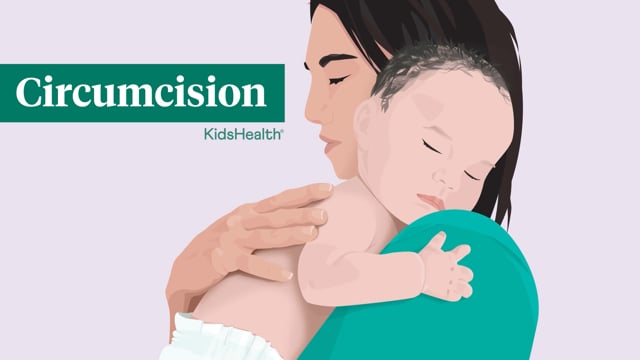Circumcision
What Is Circumcision?
A hood of skin, called the foreskin, covers the head (or glans) of the penis. In circumcision, the foreskin is surgically removed, exposing the end of the penis.
Some families choose to circumcise based on cultural or religious beliefs. Others choose to for hygiene or appearance. And some choose not to circumcise.
Most circumcisions are done during the first 10 days (often within the first 48 hours) of a baby's life. They're done either in the hospital by the pediatrician, family doctor, or obstetrician, or, for some religious ritual circumcisions, at home. The doctor will discuss the procedure and the possible risks with the baby's parents.
Premature babies or those who have special medical concerns may need extra time until they can be circumcised. Some babies are born with physical problems affecting the penis that will be fixed with surgery. They may not be circumcised because doctors use the foreskin as part of the reconstructive operation.
Sometimes, families decide to wait to circumcise so that they or their child can make the choice later. Circumcision after the newborn period usually is done in an operating room with the child getting general anesthesia, and comes with some additional risks.

Circumcision
What Are the Benefits of Circumcision?
Those who are circumcised have a lower likelihood of:
- getting HIV and other sexually transmitted diseases (STDs) when they are older
- developing urinary tract infections (UTIs), especially in the first year of life
- getting cancer of the penis, which is rare in those who are both circumcised and uncircumcised. It is not yet clear if the decreased risk is related to circumcision itself or differences in hygiene.
- developing irritation, inflammation, or infection of the penis, because it is easier to keep a circumcised penis clean
What Are the Risks of Circumcision?
Like any surgical procedure, circumcision has some risks. These are rare but include:
- bleeding, which is usually a small amount. Be sure to tell the doctor know about any bleeding disorders in the family, as these can cause more significant bleeding after a circumcision.
- infection, which is usually mild and easy to treat
- more skin or less skin removed than planned
- scar tissue forming
Some people feel that circumcision may lessen the sensitivity of the tip of the penis, decreasing sexual pleasure later in life. This has not been proven in studies to date.
One known downside of circumcision is pain. In the past, it wasn't common to give pain relief to infants for a circumcision. But now pain medicine is recommended to help keep them comfortable. This can be a cream put on the penis beforehand, or medicine injected into the area to numb it for the circumcision. Both types wear off soon, so you can give acetaminophen to keep your baby comfortable after the procedure. Giving a pacifier dipped in sugar water and swaddling also can help babies be calmer and more comfortable.
How Do We Care for a Circumcised Penis?
Following circumcision, it is important to keep the area as clean as possible. Gently clean with warm water — do not use diaper wipes. Soapy water can be used if needed. The doctor may recommend only sponge baths until the area is healed. Newborns should only have sponge baths until their umbilical cord has fallen off.
If there is a dressing on the incision, apply a new one (with petroleum jelly) whenever you change a diaper for the first day or two. Even after the dressing is no longer needed, put a dab of petroleum jelly on the penis or on the front of the diaper until the penis is healed. This can help avoid discomfort from the penis rubbing on or sticking to the diaper.
If a plastic ring (called a plastibell) was used for the circumcision, it should be allowed to fall off on its own. This usually takes 5 to 10 days.
It usually takes between 7 to 10 days for a circumcised penis to heal. Initially the tip may appear slightly swollen and red, and you may notice a small amount of blood on the diaper. You also may notice a slight yellow discharge or crust after a couple of days. This is part of the normal healing process.
If you notice any of these problems, call your doctor right away:
- lasting bleeding or blood on the diaper (more than quarter-sized)
- increasing redness
- fever
- other signs of infection, such as worsening swelling or discharge, or pus-filled blisters
- not peeing normally within 8 hours after the circumcision
- the plastic ring (plastibell) does not fall off after 10 days
How Do We Care for an Uncircumcised Penis?
As with a penis that's circumcised, an uncircumcised one should be kept clean. Also, no cotton swabs, astringent, or any special bath products are needed — just warm water every time you bathe your baby is enough.
Initially, do not pull back the foreskin to clean beneath it. Over time, the foreskin will retract on its own so that it can be pulled away easily from the glans toward the belly. This happens at different times for different boys, but most can retract the foreskin by the time they reach puberty.
As your son grows up, teach him to wash beneath the foreskin by gently pulling it back from the glans, rinsing the glans and the inside of the foreskin with warm water, then pulling the foreskin back over the head of his penis.


